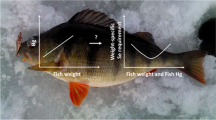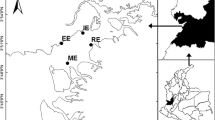Abstract
Recently, there have been reports of increasing amounts of mercury (Hg) in muscles of beluga (Huso huso, Brandet 1869) in the Caspian Sea which exceeds its guideline level for food in the UK. Our intensive effort was to investigate the effects of dietary methylmercury (MeHg) on Beluga bioenergetics. Beluga juveniles were fed with four diets containing MeHg (control: 0.04 mg kg−1; low: 0.76 mg kg−1; medium: 7.88 mg kg−1; and high: 16.22 mg kg−1) for 70 days. There were significant differences in food consumption among the treatment groups. After 42 days, all individuals of the high dose died. After 35 and 70 days, all treatment groups (low, medium and high) showed a significant decline in their growth rate, unlike the control group. They also showed considerable lower specific growth rates (SGR) comparing to the control group. All treatment groups assimilated the dietary MeHg into their muscle tissue in a dose-dependent manner. Assimilation percent was significant among the treatment groups at days 35 and 70, but it was lower in the first 35 days than in the second 35 days. The data obtained from the dietary MeHg concentration and bioaccumulation rates were modeled for better natural resources management of the Caspian Sea.


Similar content being viewed by others
Abbreviations
- SGR:
-
Specific growth rates
- GCE:
-
Gross conversion efficiency
- FCR:
-
Food consumption rate
- AAS:
-
Atomic Absorption Spectrometer
- SRM:
-
Standard Reference Materials
- NIST:
-
National Institute of Standards and Technology
- CF:
-
Condition factor
References
Agency for Toxic Substances, Disease Registry (ATSDR) (1999) Toxicological profile for mercury. Centers for Disease Control. Atlanta, Georgia
Agusa T, Kunita T et al (2004) Concentration of trace elements in muscle of sturgeons in the Caspian Sea. Mar Pollut Bull 49:780–789
Al-Majed NB, Preston MR (2000) Factors influencing the total mercury and methyl mercury in the hair of the fishermen of Kuwait. Environ Pollut 109:239–250
Atchison WD, Hare MF (1994) Mechanisms of methylmercury-induced neurotoxicity. FASEB J 8:622–629
Bahmani M, Tavakoli M et al (2005) Study on stock operation and renew trend of sturgeon's fish in Iran. 6th Marine science conference, Tehran, Iran, 21–25 September 2005
Bernardi P, Petronelli V (1996) The permeability transition pore as a mitochondrial calcium release channel: a critical appraisal. J Bioenerg Biomembr 28:131–138
Berntssen MHG, Aatland A et al (2003) Chronic dietary mercury exposure causes oxidative stress, brain lesions, and altered behavior in Atlantic salmon (Salmo salar) parr. Aquat Toxicol 65:55–72
Billard R, Lecointre G (2001) Biology and conservation of sturgeon and paddle fish. Rev Fish Biol Fish 10:355–392
Bloom NS (1992) On the chemical form of mercury in edible fish and marine invertebrate tissue. Can J Fish Aquat Sci 49:1010–1017
Boudou A, Delnomdedieu M et al (1991) Fundamental roles of biological barriers in mercury accumulation and transfer in freshwater ecosystems. Water Air Soil Pollut 56:807–821
Castoldi AF, Coccini T et al (2001) Neurotoxicity and molecular effects of methylmercury. Brain Res Bull 55(2):197–203
Clarkson TW (1994) The toxicology of mercury and its compounds. In: Watras CJ, Huckabee JW (eds) Mercury pollution: integration and synthesis. Lewis Publishers, Boca Raton, FL, pp 631–640
Crespo-Lopez ME, Sa AL et al (2007) Methylmercury genotoxicity: A novel effect in human cell lines of the central nervous system. Environ Int 33:141–146
Dervnick PE, Sandheinrich MB (2003) effects of dietary methylmercury on reproductive endocrinology of fathead minnows. Environ Sci Technol 37(19):4390–4396
Devlin EW (2006) Acute toxicity, uptake and histopathology of aqueous methyl mercury to fathead minnow embryos. Ecotoxicol 15:97–110
Eisler R (2004) Mercury hazards from gold mining to humans, plants, and animals. Rev Environ Contam Toxicol 181:139–198
Friedmann AS, Costain EK et al (2002) Effect of mercury on general and reproductive health of largemouth bass (Micropterus salmoides) from three lakes in New Jersey. Ecotoxicol Environ Saf 52:11–122
Gochfeld M (2003) Cases of mercury exposure, bioavailability, and absorption. Ecotoxic Environ Saf 56:174–179
Houck A, Cech JJ (2004) Effect of dietary methylmercury on juvenile Sacramento blackfish bioenergetics. Aquat Toxicol 69:107–123
Hurtvitz A, Degani G et al (2005) Cloning of FSHβ, LHβ, and glycoprotein α subunits from the Russian Sturgeon (Acipenser gueldenstaedtii), β-subunit mRNA expression, gonad development, and steroid levels in immature fish. Gen Comp Endocrinol 140:61–73
Johnson JD, Chang JP (2005) Calcium buffering activity of mitochondria controls basal growth hormone secretion and modulates specific neuropeptide signaling. Cell Calcium 37:573–581
Kang MS, Jeong JY et al (2006) Methylmercury-induced toxicity is mediated by enhanced intracellular calcium through activation of phosphatidylcholine-specific phospholipase C. Toxicol Appl Pharmacol 216:206–215
Limke TL, Heidemann SR et al (2004) Disruption of intraneuronal divalent cation regulation by methylmercury: are specific targets involved in altered neuronal development and cytotoxicity in methylmercury poisoning? Neurotoxicology 25:741–760
Mateo I (2007) A bioenergetics based comparison of growth conversion efficiency of Atlantic Cod on Georges Bank and in the Gulf of Maine. J Northw Atl Fish Sci 38:23–35
Miller K, Sandheinrich M (2002) Effects of dietary methylmercury on reproductive behavior of male fathead minnows. Conference of SETAS 2002. Salt Lake City, Utah, 18–21 September 2002
National Research Council (NRC) (2000) Toxicological effects of methylmercury board on environmental studies and toxicology. Commission on life sciences, National Research Council, National Academy Press, Washington, DC
Oliviera Robeiro CA, Belger L et al (2002) Histopathological evidence of inorganic mercury and methylmercury toxicity in the Artic charr (Salvelinus alpinus). Environ Res 90:217–225
Oliviera Robeiro CA, Filipak Neto F et al (2006) Hematological findings in neotropical fish Hoplias malabaricus exposed to subchronic and dietary doses of methylmercury, inorganic lead, and tributyltin chloride. Environ Res 101:74–80
Pourali HR, Mohseni M et al (2006) مقايسه ميزان رشد فيل ماهي در آب لب شور و شيرين (Comparison of Beluga (Huso huso) growth rate in brackish and fresh-water). Tehran, Iran
Rodgers DW, Beamish FWH (1982) Dynamics of dietary methylmercury in rainbow trout Salmo gairdneri. Aquat Toxicol 2:271–290
Shafer TJ (1998) Effects of Cd+2, Pb2+ and CH3Hg+ on high Voltage-activated calcium currents in pheochromocytoma (PC12) cells: potency, reversibility, interactions with extracellular Ca2+ and mechanisms of block. Toxicol Lett 99:207–221
Sorensen EM (1991) Metal poisoning in fish. CRC Press, Boca Raton, FL
Webb MAH, Feist GW et al (2006) Mercury concentrations in gonad, liver, and muscle of White Sturgeon Acipenser transmontanus in the Lower Columbia River. Environ Contam Toxicol 50:443–451
Wiener JG, Spry DJ (1996) Toxicological significance of mercury in freshwater fish. In: Redmon-Norwood AW (ed) Environmental contaminants in wildlife, interpreting tissue concentrations. CRC/Lewis Publishers, Boca Raton, Fla
Weiner RI, Charles A (2001) Regulation of gonadotropin-releasing hormone release by cyclic AMP signalling pathways. Growth Horm IGF Res 2001, Supplement A (11):S9–S15
Weis JS, Weis P (1994) Effects of embryonic exposures to methylmercury on larval prey-capture ability in the mummichog (Fundulus heteroclitus). Environ Toxicol Chem 14:153–156
Acknowledgements
We thank Dr. Houck and Dr. Cech for manuscript review, Mrs. Karami, Mr. Nazeri and Dr. Akrami for their time and energy, Dr. Ghasempouri for technical assistance in Mercury analysis, and all staff of the Natural Resource and Marine Science Faculty of Tarbiat Modares University (T.M.U.) for financial support and corporation.
Author information
Authors and Affiliations
Corresponding author
Rights and permissions
About this article
Cite this article
Gharaei, A., Esmaili-Sari, A., Jafari-shamoshaki, V. et al. Beluga (Huso huso, Brandet 1869) bioenergetics under dietary methylmercury. Fish Physiol Biochem 34, 473–482 (2008). https://doi.org/10.1007/s10695-008-9224-3
Received:
Accepted:
Published:
Issue Date:
DOI: https://doi.org/10.1007/s10695-008-9224-3




